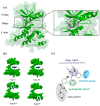The Interactions of Nintedanib and Oral Anticoagulants-Molecular Mechanisms and Clinical Implications
- PMID: 33396592
- PMCID: PMC7795697
- DOI: 10.3390/ijms22010282
The Interactions of Nintedanib and Oral Anticoagulants-Molecular Mechanisms and Clinical Implications
Abstract
Nintedanib is a synthetic orally active tyrosine kinase inhibitor, whose main action is to inhibit the receptors of the platelet-derived growth factor, fibroblast growth factor and vascular endothelial growth factor families. The drug also affects other kinases, including Src, Flt-3, LCK, LYN. Nintedanib is used in the treatment of idiopathic pulmonary fibrosis, chronic fibrosing interstitial lung diseases and lung cancer. The mechanism of action suggests that nintedanib should be considered one of the potential agents for inhibiting and revising the fibrosis process related to COVID-19 infections. Due to the known induction of coagulation pathways during COVID-19 infections, possible interaction between nintedanib and anticoagulant seems to be an extremely important issue. In theory, nintedanib could increase the bleeding risk, thrombosis and lead to thrombocytopenia. The data from clinical trials on the concomitant use of nintedanib and antithrombotic agents is very limited as this patient group was within the standard exclusion criteria. Nintedanib is an important therapeutic option, despite its interaction with anticoagulants. If anticoagulant therapy is necessary, the more effective and safer option is the concomitant administration of DOACs and nintedanib, especially when drug-monitored therapy will be used in patients at high risk of bleeding complications.
Keywords: direct oral anticoagulants; idiopathic pulmonary fibrosis; nintedanib.
Conflict of interest statement
The authors declare no conflict of interest.
Figures




Similar articles
-
Anticoagulant Use and Bleeding Risk in Central European Patients with Idiopathic Pulmonary Fibrosis (IPF) Treated with Antifibrotic Therapy: Real-World Data from EMPIRE.Drug Saf. 2020 Oct;43(10):971-980. doi: 10.1007/s40264-020-00978-5. Drug Saf. 2020. PMID: 32734423 Free PMC article.
-
Nintedanib: a novel therapeutic approach for idiopathic pulmonary fibrosis.Respir Care. 2014 Sep;59(9):1450-5. doi: 10.4187/respcare.03023. Epub 2014 Apr 29. Respir Care. 2014. PMID: 24782550 Review.
-
Nintedanib for the treatment of idiopathic pulmonary fibrosis.Expert Opin Pharmacother. 2018 Feb;19(2):167-175. doi: 10.1080/14656566.2018.1425681. Epub 2018 Jan 12. Expert Opin Pharmacother. 2018. PMID: 29327616 Review.
-
[Nintedanib in the treatment of fibrosing interstital lung diseases].Pol Merkur Lekarski. 2018 Mar 27;44(261):139-141. Pol Merkur Lekarski. 2018. PMID: 29601564 Review. Polish.
-
Nintedanib: A Review of Its Use in Patients with Idiopathic Pulmonary Fibrosis.Drugs. 2015 Jul;75(10):1131-40. doi: 10.1007/s40265-015-0418-6. Drugs. 2015. PMID: 26063212 Review.
Cited by
-
A Real-World Multicenter Retrospective Observational Study on Polish Experience with Nintedanib Therapy in Patients with Idiopathic Pulmonary Fibrosis: The PolExNIB Study.J Clin Med. 2023 Jul 12;12(14):4635. doi: 10.3390/jcm12144635. J Clin Med. 2023. PMID: 37510750 Free PMC article.
-
Screening and Analysis of Possible Drugs Binding to PDGFRα: A Molecular Modeling Study.Int J Mol Sci. 2023 Jun 1;24(11):9623. doi: 10.3390/ijms24119623. Int J Mol Sci. 2023. PMID: 37298573 Free PMC article.
-
Proliferative Vitreoretinopathy in Retinal Detachment: Perspectives on Building a Digital Twin Model Using Nintedanib.Int J Mol Sci. 2024 Oct 15;25(20):11074. doi: 10.3390/ijms252011074. Int J Mol Sci. 2024. PMID: 39456855 Free PMC article. Review.
-
Evaluation of Proteasome Inhibitors in the Treatment of Idiopathic Pulmonary Fibrosis.Cells. 2022 May 4;11(9):1543. doi: 10.3390/cells11091543. Cells. 2022. PMID: 35563849 Free PMC article. Review.
-
Patient Profile-Based Management with Nintedanib in Patients with Idiopathic Pulmonary Fibrosis.Pulm Ther. 2024 Dec;10(4):377-409. doi: 10.1007/s41030-024-00271-1. Epub 2024 Sep 28. Pulm Ther. 2024. PMID: 39340742 Free PMC article. Review.
References
-
- Anatomical Therapeutic Chemical Classification System. [(accessed on 23 December 2020)]; Available online: http://www.atccode.com/
-
- J84.112—Idiopathic Pulmonary Fibrosis. [(accessed on 23 December 2020)]; Available online: https://www.unboundmedicine.com/icd/view/ICD-10-CM/881192/all/J84_112___....
Publication types
MeSH terms
Substances
LinkOut - more resources
Full Text Sources
Other Literature Sources
Medical
Miscellaneous

